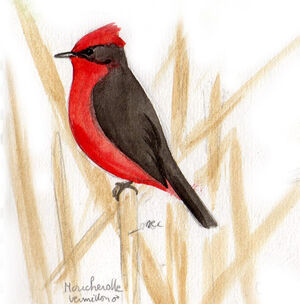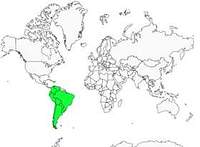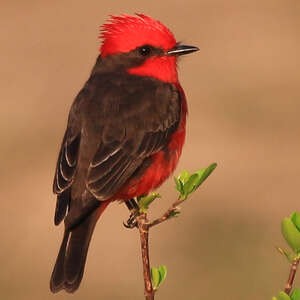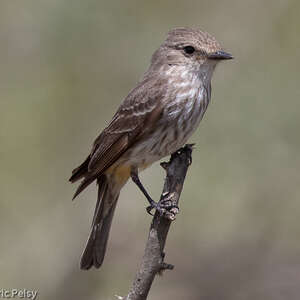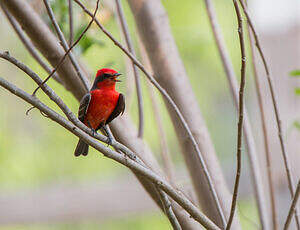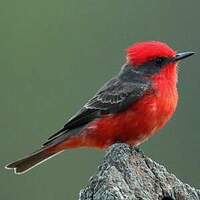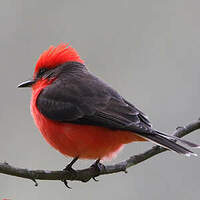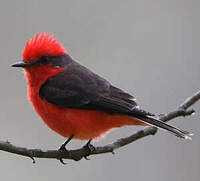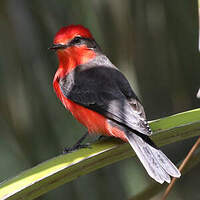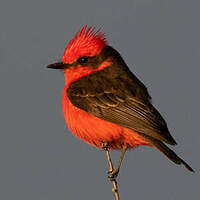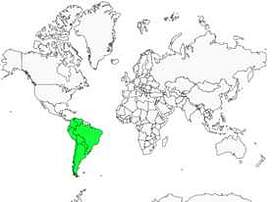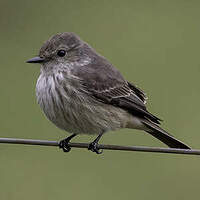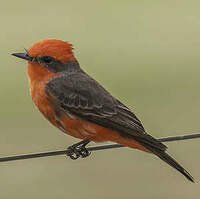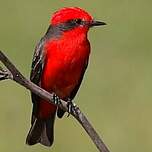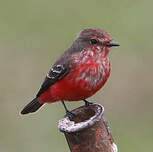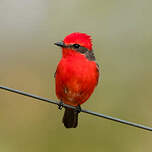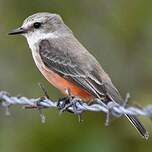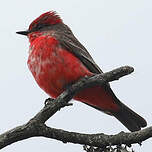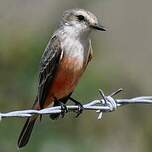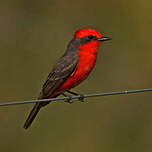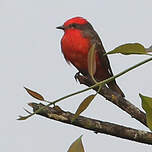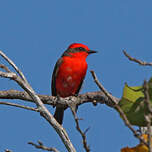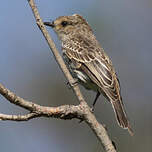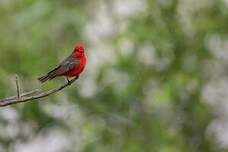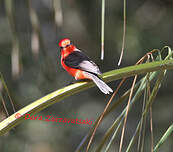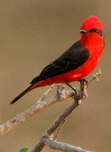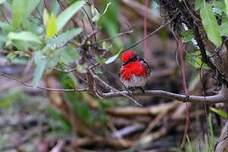Scarlet Flycatcher
Pyrocephalus rubinus - Moucherolle écarlate
Identification
The male Scarlet Flycatcher is probably the bird with the brightest colour in the family. It has a bright red head with a dark loral stripe and a brown stripe beginning in the eye and reaching up to the nape, passing through the parotic feathers that can be erected in a crest. The lower part from the beak to the tail is of the same vivid vermilion red. The upper parts are dark, covered feathers of quite a warm brown and wing and tails feathers rather of a blackish brown. The uniformity in the upper parts is broken by light edging of feathers and remiges. The light tip of the first remiges draws two thin wing bars. The parts hidden by the wings at rest - back, rump and uppertail -are of a lighter brown and form a great contrast to the mantle and the very dark tail. The iris is dark, beak and legs black.
The female differs totally from the male. Its upper parts are rather greyish and lighter brown and present a contrast between body and the rest. Most feathers have light edging contributing to the overall lightness. The tail is edged light. Chin, throat and upper breast are white and have dark streaks of varying intensity, reminding of the grey flycatcher and extending to theflanks. The lower breast is slightly beige and occasionally, in some individuals, progressively passes to a more or less vivid reddish or pinkish colour on the belly and undertail.
The juvenile looks like the female but with streaks and edging more marked. The immature male resembles the female but the red filling its lower parts reveals its identity.
The species is monotypic.
Subspecific information monotypic species
Foreign names
- Moucherolle écarlate,
- Mosquero cardenal,
- príncipe,
- Rubintyrann,
- rubinfejű tirannusz,
- Scharlaken Tiran,
- Pigliamosche vermiglio,
- rubintyrann,
- Rubintyrann,
- pamuchár tmavochrbtý,
- tyranovec rubínový,
- Rubintyran,
- rubiinityranni,
- mosquer cardenal,
- żarek rubinowy,
- rubīna tirāniņš,
- Огненный мухоед,
- ベニタイランチョウ,
- 猩红霸鹟,
- rubintyrann,
- 猩紅霸鶲,
Voice song and call
When foraging or interacting aggressively, both sexes make peents, pisks or peeps with great raspiness. The male usually sings at dawn. During flight displays, it will communicate throughout the day and often into the evening and maybe night, producing ching-tink-a-le-tinks, p-p-pik-zees or pit-a-zees, which it repeats many times. Flight song is quite variable, from titi'tr'e'e'es, to t-t-ti-ti-tee-teeurs and sometimes even pt-pt-pre-ee-sees. When she is inviting her partner to copulate or interacting aggressively with unwanted males, the female makes tjee-tjee-tjee sounds. The chatter is quite similar to song but usually delivered more weakly. Wing vibration and bill clapping can also be heard during flight displays or during movements between perches. Migrants are rather silent.
Habitat
Behaviour character trait
Dietfeeding habits
Scarlet Flycatchers are mainly insectivorous: they consume arthropods including butterflies, orthoptera (grasshoppers and crickets), beetles (Coleoptera), termites, bees and spiders. They detect their prey from a low perch (up to about 10 meters high) and capture them in flight or on the ground.
Reproduction nesting
The breeding season in Argentina runs from October to January. During the breeding season, the male Scarlet Flycatcher will hover up to 20 or 30 meters above the ground and then back down to its perch.
The nest is an open cup that appears fragile or sloppily made, it is built with twigs, herbs, roots, vegetable fibers, lichen, and cocoons. It is lined with spider webs and padded with down, horsehair, and feathers. The external diameter can reach 8 centimeters and the height 5 cm. The structure is usually placed between 2.5 and 6 meters above the ground, but sometimes at a much higher height of up to 18 meters on the bare and horizontal fork of a tree or bush.The clutch contains 2 or 3 eggs which are incubated by the female alone for 15-16 days. The duration of the young staying in the nest is of equal duration. Both parents take care of the young, although the females spend more time in the nest. The male supplies food to his mate. Predation is the main cause of failure.
Geographic range
The Scarlet Flycatcher can be found in southeastern Bolivia, Paraguay, and southeastern Brazil to Argentina and Uruguay. The birds from the south of the breeding range are migratory, and head towards the north during the southern winter, spreading out over a large area of Brazil and the Amazonian portions of Bolivia, Peru, Ecuador, and Colombia, with the Andes separating them from the vermilion Flycatchers found to the west in the Pacific region.
Threats - protection
Sources of information
- IOC World Bird List (v15.1), Gill, F and D Donsker (Eds). 2025-12-07.
- Avibase, Lepage Denis
- HBW Alive,
- xeno-canto, Sharing bird sounds from around the world,
Other sources of interest
 Specification sheet created on
28/10/2023 by Daniel Le-Dantec
Specification sheet created on
28/10/2023 by Daniel Le-Dantec partially rewritten on 00/00/0000 by Jean François
Translation by AI Oiseaux.net
© 1996-2025 Oiseaux.net
- Accipitriformes
- Aegotheliformes
- Anseriformes
- Apodiformes
- Apterygiformes
- Bucerotiformes
- Caprimulgiformes
- Cariamiformes
- Casuariiformes
- Charadriiformes
- Ciconiiformes
- Coliiformes
- Columbiformes
- Coraciiformes
- Cuculiformes
- Eurypygiformes
- Falconiformes
- Galliformes
- Gaviiformes
- Gruiformes
- Leptosomiformes
- Mesitornithiformes
- Musophagiformes
- Nyctibiiformes
- Opisthocomiformes
- Otidiformes
- Passeriformes
- Pelecaniformes
- Phaethontiformes
- Phoenicopteriformes
- Piciformes
- Podargiformes
- Podicipediformes
- Procellariiformes
- Psittaciformes
- Pterocliformes
- Rheiformes
- Sphenisciformes
- Steatornithiformes
- Strigiformes
- Struthioniformes
- Suliformes
- Tinamiformes
- Trogoniformes

